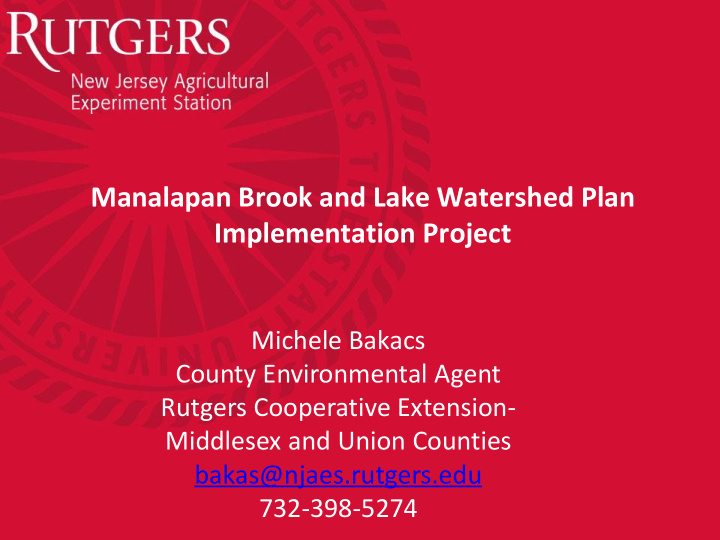



Manalapan Brook and Lake Watershed Plan Implementation Project Michele Bakacs County Environmental Agent Rutgers Cooperative Extension- Middlesex and Union Counties bakas@njaes.rutgers.edu 732-398-5274
Manalapan Watershed Location • 43 mi 2 watershed • 10 municipalities • 2 counties • Confluence with Matchaponix • Flows into the South River • Largest impoundment- Manalapan Lake
Problem and History • Lake- highly turbid and can have high density of aquatic plants • Causes problems for lake recreation and ecology • Brook- sediment erosion and deposition • Modeling conducted by Princeton Hydro Photo credit: Princeton Hydro showed a 64% reduction in TSS loading was needed (4,527 tons of sediment) in order to meet surface water quality standards. • SWQS for FW2-NT, TSS <40mg/L
Manalapan Brook and Lake
Implementation Partners NJDEP 319 (h) Program • Watershed Restoration Plan Approved-2011 • NJ Water Supply Authority (grantee) • Goal- Target potential sites for implementation projects to achieve the targeted watershed-wide suspended sediment load reductions and desired water quality goals. • Plan Implementation Phase- 2013 • Freehold Soil Conservation District (grantee) • Princeton Hydro • Middlesex County Parks and Recreation; Planning; Mosquito Commission; Rutgers Cooperative Extension • Township of Monroe • Township of Manalapan
Restoring the Manalapan Watershed Video Series http://freeholdsoil.org/conservation-projects/projects/
Implementation Projects Basin retrofits and naturalization Summer/Fall, 2016 • 3 basin retrofits-2 in Manalapan, 1 in Monroe • Remove concrete low flow channels • Creating a forebay and stone filter berms • Elongating and re-designing the stormwater flow path to enhance infiltration and pollutant uptake • Planting of native vegetation
Implementation Projects Shoreline stabilization- summer, 2016 • 600 feet of shoreline • Native plants • Regrading • Erosion control material
Implementation Projects Floating Wetland Islands Spring, 2014 • Recycled plastic material • Native plants • High surface area • Microbes assimilate nutrients • Habitat value and aesthetically pleasing Photo credit Princeton Hydro
What makes a good watershed plan? • Implementable • Good leadership and partners who communicate • Communication with NJDEP grant manager • Cost effective implementation projects • Necessary technical expertise for planning, implementation, and maintenance Thompson Park Rain Garden- Project #1 Michele Bakacs County Environmental Agent Rutgers Cooperative Extension Middlesex and Union Counties bakacs@njaes.rutgers.edu, 732-398-5274
Recommend
More recommend